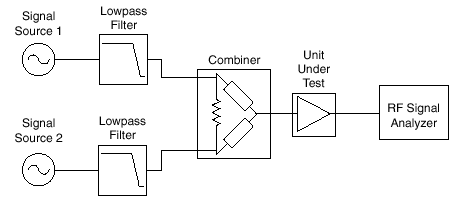Two-Tone Third-Order Intermodulation Distortion Measurement
Two-tone third-order intermodulation distortion (IMD3) is the measure of the third-order distortion products produced by a nonlinear device when two tones closely spaced in frequency are fed into its input. This distortion product is usually so close to the carrier that it is almost impossible to filter out and can cause interference in multichannel communications equipment.
If F1 and F2 are the frequencies of the two tones, then the third-order distortion products occur on both sides of these tones at 2F2 – F1 and 2F1 – F2. Assuming that the power levels of the two tones are equal, IMD3 is the difference between the power of the fundamental signals and the third-order products, as defined in the following equation:

where o refers to the output of the UUT, Po3 is the power level of one of the output third-order products, and Po is the power level of one of the fundamental tones.
The math becomes more involved if the powers of the two tones are different. After you measure the IMD3, calculate the UUT output third-order intercept point (OIP3) using the following equation:

The input third-order intercept point (IIP3) is defined as:

where G is the gain of the device. The IIP3 number quantifies the third-order linearity of a device. Use the IIP3 specification of the RF Signal Analyzer as a guide to optimize its settings when measuring the IMD3 of an external device.
The two tones injected into the UUT must be free from any third-order products. These two tones are combined, or summed, at or before the UUT input. If the two tones are not well isolated, they intermodulate with each other and cause distortion. A signal combiner with good input-to-input isolation is recommended to minimize distortion of the input tones.
Measurement Setup
A typical IMD3 measurement setup is shown in the figure below. Lowpass filters are employed at the source outputs to suppress harmonics.

Typical IMD3 Measurement Setup
Understanding Two-Tone Third-Order Intermodulation Distortion Limits of the RF Signal Analyzer
The RF Signal Analyzer generates its own distortion spurs, which are capable of swamping the Po3 of the UUT and giving rise to an erroneous measurement. Too much power at the signal input of the RF Signal Analyzer may drive the system into a nonlinear region of operation and produce very large distortion products. Choosing an appropriate attenuation setting for the RF Signal Analyzer minimizes its IMD3 contribution to the measurement. The IMD3 improves by 2 dB for every 1 dB of input power decrement.
To measure the IMD3 of a UUT, input power to the RF Signal Analyzer mixer must satisfy the following condition:

where IIP3rfsa is the input third-order intercept point of the RF Signal Analyzer (about 10 dBm). For example, to accurately measure an IMD3 of 80 dBc the input power to the mixer must be less than 31.5 dBm.
If the powers of two-tone signals are larger than this optimal level, they must be attenuated, either with the attenuators internal to the RF Signal Analyzer or with external attenuators. However, as attenuation raises the noise floor of the RF Signal Analyzer, there is a limit to how much attenuation can be used before noise overwhelms the distortion spurs. Its spurious-free dynamic range (SFDR) specification indicates the largest IMD3 value the RF Signal Analyzer can accurately measure, assuming 0 dB attenuation and input signals whose powers satisfy the equation above.
Choosing an Optimal Setting for the RF Signal Analyzer
Complete the following steps to set optimal attenuation levels for an IMD3 measurement when the level of the third-order distortion spur (Po3) is unknown:
- Set the attenuation so that the input power at the mixer is about 30 dBm. When using the RF Signal Analyzer Demo Panel,
mixer level = reference level – attenuation.
- Tune to the third-order distortion product frequency of interest, either 2F2 – F1 or 2F1 – F2. Then decrease the resolution bandwidth until a distortion spur appears.
- Increase the attenuation level.
- If the harmonic spur decreases, repeat step 3.
- Repeat step 4 until the harmonic level does not decrease any further. Attenuation does not lower the distortion products of the signal; it only lowers the distortion products generated internally to the RF Signal Analyzer. Decrease the resolution bandwidth to lower the noise floor.
The setting you obtain is the optimal attenuation setting.